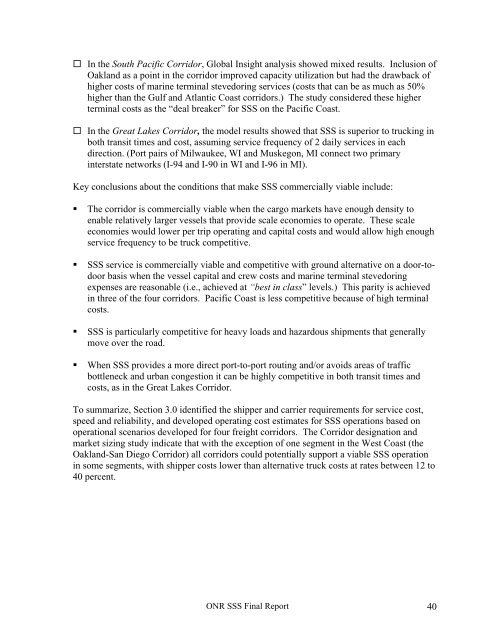Office of Naval Research - National Transportation Library
Office of Naval Research - National Transportation Library
Office of Naval Research - National Transportation Library
You also want an ePaper? Increase the reach of your titles
YUMPU automatically turns print PDFs into web optimized ePapers that Google loves.
In the South Pacific Corridor, Global Insight analysis showed mixed results. Inclusion <strong>of</strong>Oakland as a point in the corridor improved capacity utilization but had the drawback <strong>of</strong>higher costs <strong>of</strong> marine terminal stevedoring services (costs that can be as much as 50%higher than the Gulf and Atlantic Coast corridors.) The study considered these higherterminal costs as the “deal breaker” for SSS on the Pacific Coast. In the Great Lakes Corridor, the model results showed that SSS is superior to trucking inboth transit times and cost, assuming service frequency <strong>of</strong> 2 daily services in eachdirection. (Port pairs <strong>of</strong> Milwaukee, WI and Muskegon, MI connect two primaryinterstate networks (I-94 and I-90 in WI and I-96 in MI).Key conclusions about the conditions that make SSS commercially viable include:• The corridor is commercially viable when the cargo markets have enough density toenable relatively larger vessels that provide scale economies to operate. These scaleeconomies would lower per trip operating and capital costs and would allow high enoughservice frequency to be truck competitive.• SSS service is commercially viable and competitive with ground alternative on a door-todoorbasis when the vessel capital and crew costs and marine terminal stevedoringexpenses are reasonable (i.e., achieved at “best in class” levels.) This parity is achievedin three <strong>of</strong> the four corridors. Pacific Coast is less competitive because <strong>of</strong> high terminalcosts.• SSS is particularly competitive for heavy loads and hazardous shipments that generallymove over the road.• When SSS provides a more direct port-to-port routing and/or avoids areas <strong>of</strong> trafficbottleneck and urban congestion it can be highly competitive in both transit times andcosts, as in the Great Lakes Corridor.To summarize, Section 3.0 identified the shipper and carrier requirements for service cost,speed and reliability, and developed operating cost estimates for SSS operations based onoperational scenarios developed for four freight corridors. The Corridor designation andmarket sizing study indicate that with the exception <strong>of</strong> one segment in the West Coast (theOakland-San Diego Corridor) all corridors could potentially support a viable SSS operationin some segments, with shipper costs lower than alternative truck costs at rates between 12 to40 percent.ONR SSS Final Report 40
















